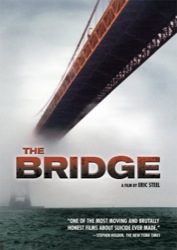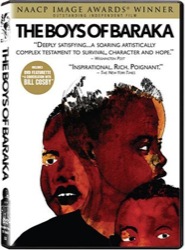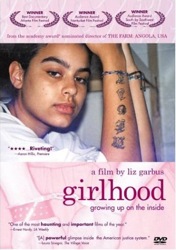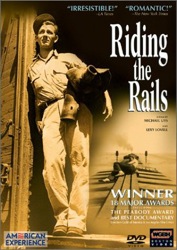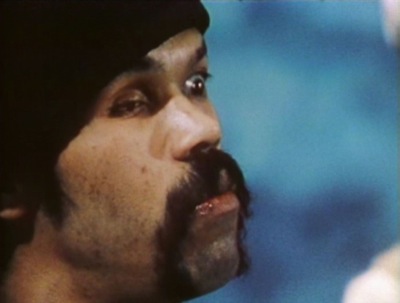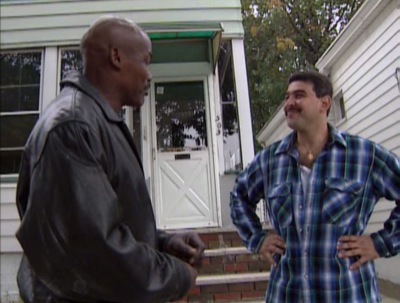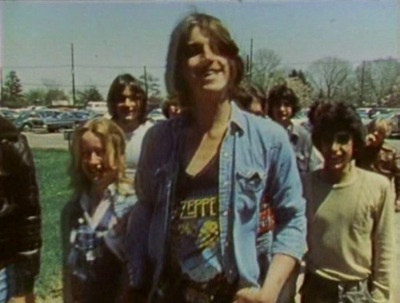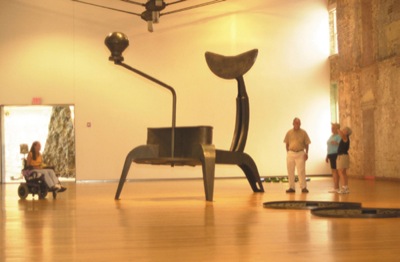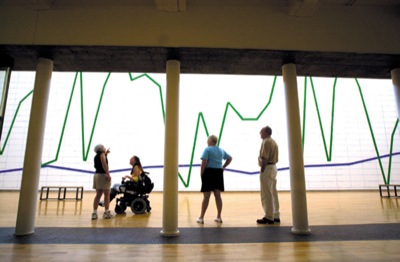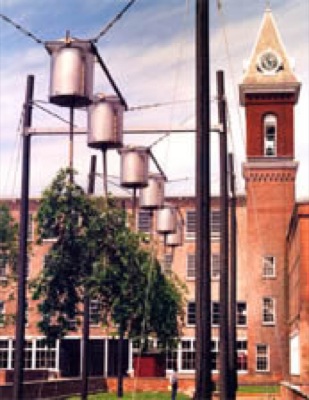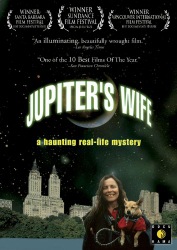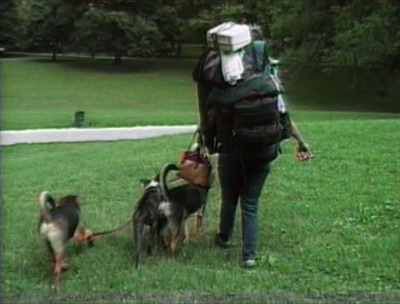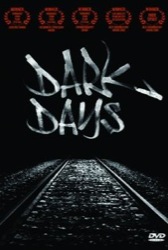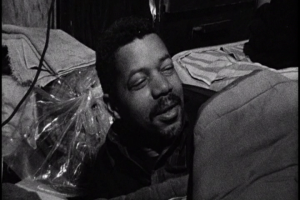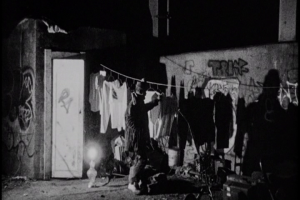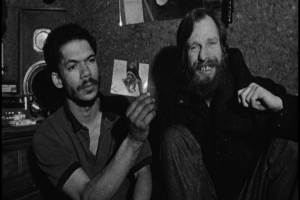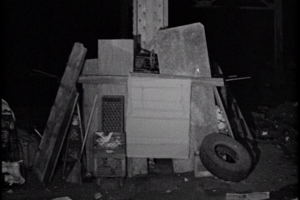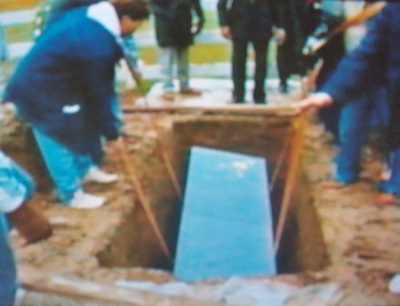Disenfranchised / downtrodden
The Bridge
This film is about public suicides. They all take place on the world’s most popular suicide destination, the Golden Gate Bridge. Every two weeks someone jumps off the Bridge. For 12 months filmmaker Eric Steel and crew kept a cinematic vigil and filmed the jumpers (when his radio calls to police could not rescue them). He then interviewed their surviving family and friends. The stories of the jumpers are sobering and dispiriting. Their departed selves share a common thread of depression, despair, and chronic mental illness. Although it shows sensational footage of their plunges, this is not a sensational film. Indeed it is depressing and immensely sad. There is nothing uplifting, heroic, or romantic about it, even when it succeeds in getting you into the mind-set of the jumpers. Regrettably the film does not explore why this Bridge out of all other bridges, why jumpers usually face the city rather than the ocean, why these suicides are so public and dramatic, and why the controversy around a proposed fence won’t go away — or any of another dozen frequent questions about suicides on this Bridge. Despite its title, this film is not about the Bridge. Rather it focuses solely on the lives and deaths of a handful of desperate people who jumped during the year of filming. It’s a troublesome film, but memorable. You definitely need to be in the right state of mind to watch it.
— KK
The Bridge
Eric Steel
2006, 94 min.
$18, DVD
Read more about the film at Wikipedia
Rent from Netflix
Available from Amazon
The Boys of Baraka
Extreme interventions in the lives of desperate kids in the hopes of turning them around are almost a sub-genre of documentaries (not to mention the two dozen Hollywood heartwarmers based on true stories). The techniques in real life are varied, and they all work to some extent. In documentaries we have heroic teachers ( A Touch of Greatness), neglected art programs (Something Within Me), visits to jail (Scared Straight!), juvenile detention (Girlhood), and now boarding school in Africa.
Twenty African-American 13-year-old at-risk boys in the projects of Baltimore, MD are sent to a remote boarding school in the countryside of Kenya. There they meet people superficially like themselves (poor and black) but with a whole different set of assumptions and perspectives. They also meet teachers who invest all their talents and attention on them. Of course it changes their lives. Even though political strife closes the school after one year, those 10 months of middle school is enough to turn most of them around. Considering the neighborhood and family dynamics the kids have had to battle, it’s an inspiring achievement. There’s an update on the kids as they head into high school in the bonus features that I wish had been part of the film.
–KK
The Boys of Baraka
Heidi Ewing and Rachel Grady
2005, 84 min.
$5, DVD
Read more about the film at Wikipedia
Rent from Netflix
Available from Amazon
Girlhood
Girlhood follows two young girls, arrested for crime in Baltimore, MD, as they journey through adolescence and the juvenile justice system, two of the most difficult transitions one can think of. One girl murdered a friend when she was 12, the other has a mother in jail herself. As the years pass their institutionalized lives diverge, and the girls’ futures are hard to predict or even imagine, which is what gives this film its satisfying drama. Surprisingly one girl reforms, goes to high school and graduates 4th in her class; the other continues to battle demons inside. This film captures almost 5 years of their lives; the girls are almost adults by the end. We get a good sense of who they are, what it takes to make it in their world, and who and what helps them.
— KK
Girlhood
Liz Garbus
2003, 82 min.
$15, DVD
Rent from Netflix
Available from Amazon
Watch the trailer at IMDB
Riding the Rails
I learned something I didn’t know. In addition to the millions of men who became hobos during the Great Depression in the US, this disruption also unleashed 250,000 teenagers onto the roads. These teenage hobos were in many ways like the hippies who would follow them a generation later. Almost on cue from some hidden silent signal, they left the farm at age 16 and hopped a freight train to anywhere. They were dropping out. Exploring. Seeing what was down the road. Looking for something. On the rails they met thousands of others exactly like them with the same idea. They were vigorously unwelcomed around the country; there wasn’t enough work or food for the unemployed adults; as kids they were “urged” to move on. Their time on the rails and in rail camp “jungles” was harsh and sobering. In response to this tremendous social problem, Roosevelt set up the CCC, a kind of boot camp that turned these restless kids into an army that built many wilderness parks in the US. This brief season of freight hopping youth didn’t last many years, but for the quarter million kids who rode the rails then, it was the experience of their life (until WWII came along). This documentary gives some idea of what that young life on the rail road was like.
— KK
Riding the Rails
Directed by Lexy Lovell and Michael Uys
1998, 72 min.
$11, DVD
Rent from Netflix
Available from Amazon
Scared Straight!
In 1978 a bus-load of cocky juvenile delinquents are given a day off from school and sent to visit a federal maximum prison for an afternoon as a field trip. They are locked up for in a cell a half an hour. Then the designated “lifers” in jail proceed to scare the air out of the kids with a most graphic, explicit and X-rated picture of what awaits them inside and what their lives will be like if they stay on their current path. The kids, all hardened punks by 17, come out shaking. Like the documentary The Farm, it’s a picture of what to avoid. But unlike most films, it doesn’t stop there. The filmmakers return 20 years later. They track down each of the 15 kids and all of the convicts lifers and re-interview them to see what effect this encounter had. It is simply astounding that all but two of the kids turned their lives around 180 degrees after that one afternoon. It was the most important hours of their lives. Each person attributes the fact they are still alive to that brief meeting. It changes the lifers too. Even those who backslid have remarkable stories about what happened in those few minutes. The film is moving. It gives hope. And the movie itself is almost as good as a visit by lifers. Show it to a kid at risk that you know.
— KK
Scared Straight!
Directed by Arnold Shapiro
1978, 90 min.
$11, DVD
Read more about the film at Wikipedia
Rent from Netflix
Available from Amazon
Downside UP
Let’s say your regional industrial mill town is rusting away, bypassed. Main street is boarded up, windows in the old brick factories broken beyond repair, fine homes abandoned, and the last employer in the old company town is long gone. The stagnation is lethal. As mayor, you need something to sell in the global economy. You need some new economy commodity. You need….. modern art! This very personal, but very smart, documentary is the uplifting story of how the dying rustbelt ghetto of North Adams, Mass gambled on building a modern art museum to resurrect itself. Crazy, but it worked. It proves the current adage that artists and bohemians lead economic growth. The museum attracted starving artists, who immediately found uses for the empty factory hulks, who then demanded nice restaurants, which dragged in workers and so on. Ten years later the local yahoos who would “not cross the street for funny art” are discussing the merits of upside down trees on the promenade — from whence comes the title of this very heartwarming film. It’s simple message: art works.
— KK
Downside UP
Directed by Nancy Kelly
2002, 54 min.
$20, DVD
Available, for home use only, from Transit Media, 888-367-9154
Institutional users check New Day Films for purchase and rental pricing.
Jupiter’s Wife
A sophisticated New York City filmmmaker meets a homeless woman in Central Park, and finds her to be unusually smart, vivacious, and seemingly happy to camp year-round with her dogs. How does she get by with so much enlightened contentment? It’s soon obvious the attractive woman is certifiably crazy, operating on another plane of reality. Voices tell her she is Jupiter’s wife. But rather than flee, as any sane person would do, the filmmaker decides to unravel her story. He does this by taking her irrational claims as coded messages which he learns to interpret from her outrageous clues. He uses his investigative skills in New York to piece together her submerged life, and he then tells the fascinating story she is no longer capable of telling. It is a remarkable achievement. Although he tries to help her, in the end she returns to the park. But the film completely changed my understanding of what the voices say to the afflicted: they are a code that tries to explain. In the middle of the film you’ll want to bail because you are completely focused on someone’s derangements, but its worth hanging through to the conclusion as the filmmaker completes his amazing decipherment.
— KK [recommended by Jonathan Steigman]
Jupiter's Wife
Directed by Michel Negroponte
1995, 78 min.
$3, Amazon Instant Video rental
Read more about the film at Wikipedia
Rent from Netflix
Available from Amazon
Dark Days
The urban legend about cities of homeless living underground in the neglected corridors of New York City’s subways was partly true. For about a decade in the 80s, a colony of extremely resourceful hobos built shelters in an underground section of Penn-Central railroad beneath New York. They had stolen electricity and a few even had cold running water; many worked outside as can collectors or street vendors. and rifled garbage for uneaten restaurant food. This film documents their routines, their squabbles with each other, and their fight with the city to keep their plywood homes, filled with TVs, beds, and mini–kitchens. It’s a fight they lost. Homelessness, like everything else in life, is not uniform. These folks were exceptionally resourceful and ambitious, and the story follows them up as they leave their eccentric handmade homes to acquire subsidized housing.
— KK
Dark Days
Marc Singer
2000, 88 min
$3, Amazon Instant Video rental
Read more about the film at Wikipedia
Rent from Netflix
Available from Amazon
The Farm
A straight-on view of the legendary lifer’s prison on an old slave plantation in Louisiana, where few leave alive. It’s more honest than the TV fictional show OZ in that here some lifers find truth and happiness inside. Depicts the hell inside (I’ll be good, I promise) and of course stirs up outrage (expected) but what I find worth recommending is the inspiration it plants as you see humans blossom in the most inhumane place.
The Farm: Life Inside Angola Prison
By Jonathan Stack and Liz Garbus
1998, 100 min
$25, DVD
DVD available for purchase from Angola museum.
Read more about the film at Wikipedia
Rent from Netflix
Available from Amazon


